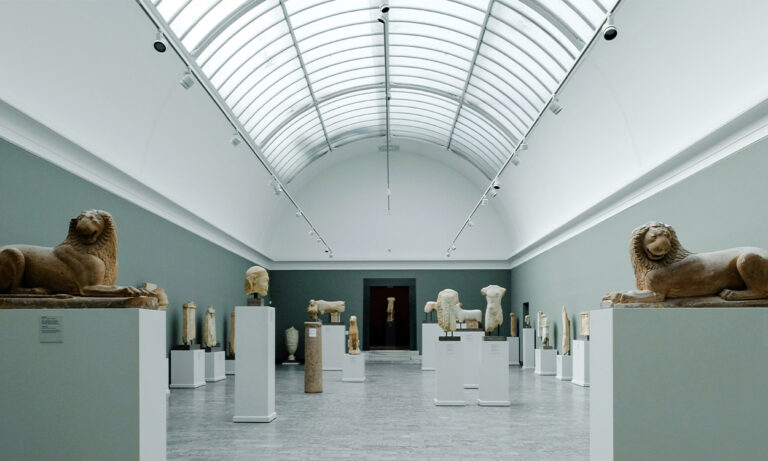New augmented reality technology might be the key to recovering and safekeeping ancient artefacts
From an ancient Egyptian sarcophagus to the Nigerian Benin Bronzes, thousands of looted artworks are finally making their way back home following increased pressure on western museums to repatriate artefacts previously stolen or ‘gifted’ during colonial rule.
In a piece for The New York Times, culture reporter Graham Bowley found that American critics had argued returning the artefacts meant museum collections “built over time by scholars and imbued by a sense of context were being randomly depleted.” And in such, US audiences were being deprived of access to iconic objects that they suggested “belong not to individual nations, but to humankind.”
Whereas, in the UK, those also opposed to the return scheme believe that keeping artefacts in relatively well-protected environments reduces the risk of theft or destruction. Both these arguments have been shunned for their “smacking of Western privilege,” as reported by The Guardian, but the question still remains. How should museums reset the balance?
Craig Stevens, 28, is a doctoral student at Northwestern University and researcher on the Back-to-Africa Heritage and Archaeology project in Liberia. The project, as stated on its website, works collaboratively with US-based researchers and Liberian partners in order to “find productive ways through which to pluralise conceptualisations of the Black/African Diaspora and consider broader processes of freedom making in the Atlantic world.”
In 2018, Stevens began incorporating 3D photogrammetry into his practice. With access to the world’s largest repository of Africana literature—found at the Herskovits library—and given his work at the National Museum of Liberia, Stevens strives to combat the deterioration of cultural heritage by using technology that grants people immersive experiences with ancient landscapes and objects.
Speaking with SCREENSHOT, the researcher explained that his role as an archaeologist is threefold: “In one way, I’m a technologist looking at ways to make the subject more relevant to the public, and more interesting to the communities they’re coming from. Each object is kind of like a different project.”
In the past year, Stevens and his team have been excavating objects from US sites to Providence Island and Liberia—the place of first arrival for black Americans when they came from the US in 1822—in an attempt to find ways of promoting a different narrative to the standard depiction of how their burial was created. This enables them to find ways to digitise the artefacts and hopefully grant the discoveries longevity.
“You can’t touch or view them because of how fragile and invaluable they are, so using these technologies allows people to interact with them. Therefore, creating a 3D rendering that people can have on their phones or computers makes archaeology more relatable and impactful for a viewer,” Stevens noted.
In 2003, non-profit organisation CyArk pioneered the application of 3D recording technologies by working with local partners in over 40 countries. One of them was Nigeria, in which they partnered up with online platform Google Arts and Culture and the Adunni Olorisha Trust in 2022 to launch the first and largest digital library of content showcasing the Osun Osogbo Sacred Grove—a UNESCO World Heritage site and one of Nigeria’s last remaining sacred groves which has recently been in danger of destruction due to flooding, heavy rain and climate change.
Another key example of how technology is working in the cultural sphere is the highly anticipated new database that listed the works of more than 5,000 looted Benin bronzes. Following the launch in November, The Art Newspaper stated that the catalogue “accelerated the restitution of the ancient African artefacts from institutions and collections worldwide.” For Scholars in Nigeria who have struggled to gain access to both the objects and archive material , the new database was a welcomed prospect.
Kokunre Agbontaen-Eghafona, a professor of cultural anthropology at the University of Benin told the publication: “The looting was like a book being torn to pieces and then the pages were put in different places. Gathering them together in one place is great.”
Augmented Reality (AR) and other advanced technologies have aided in the restoration and digitalisation of tangible cultural heritage, but they can also work as tools for people to utilise or advance their working process.
During his time in Liberia, Stevens worked closely beside locals to showcase his efforts and see their reactions first-hand. “Anytime I do a demonstration [using a digital reconstruction of a photorealistic artefact or Virtual Reality (VR) to walk to a historic structure] people are immediately shocked at how real something feels,” he explained, adding, “.they don’t necessarily have the words or vision for the potential, but they can feel that this is something powerful.”
Despite all the groundwork happening and the museum’s best efforts, the question of framing and gaze will always arise. The ongoing debate continues, with questions circulating such as who should control the scope? And who justifies what is of heritage significance? While digital technology has the power to transform societies, figures show that only 60 per cent of the world’s population have access to the internet. Therefore, archaeologists are tackling the biggest questions behind closed doors: How accessible is this method for natives?
It’s undeniable that digital infrastructure still remains a barrier in some parts of the world. For archaeologists like Stevens, however, digitisation may be the saving grace in regard to documenting rapid disappearance and deterioration—especially in Africa. The researcher summarised: “We can’t save everything, but truthfully, a lot of the meaningful aspects of heritage are within people. But being able to take things out of one particular place and placing them on the internet helps offer perspective. I think that’s the power of heritage, not necessarily just the object on its own.”





